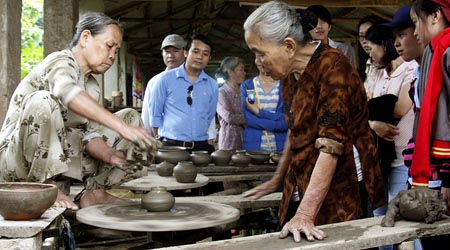There was a slogan under Nguyen Lord reign “a solider also be a workman”, the King intensively focused on training workman, hence Hue became a large manufacture so many craftsman from every regions gathered here to develop the diversity of craft village in this old capital.

Some of product in this period still remain as: Nine dynasty urns, Nine cannons, Thien Mu bell…There is some craft villages which have been carried on: Duc (bronze casting) village, Sinh folk painting village, My Xuyen fine art carpentry village, Phuoc Tich pottery village…
Duc (bronze casting) village: with the tradition continued by many generations of two families that has developed till now with bronze products which are diversity in size and style. Their products are always modified to meet the market’s demand. The traditional craftsman is not only leaves his impression on royal ornament, normal living goods but also souvenir for travelers.
Embroidery in Hue has grown in long time in feudal age. When the foreigners set the foot on Vietnam they brought advanced techniques from Western countries which made embroidered products in Hue divided into two groups: the color embroidery with traditional techniques and the white embroidered goods which have origin from France include cloths, screens, paintings, clothes. In Hue the embroidery villages was not formed as others, there are well-known embroidery artist as Le Van Hoi, Nguyen Quang Hung who were famous in feudal with honorable name “gold hand”; artist Le Di Le Van Kinh, Le Thi Bich Forum are the modern artists embroidery.
My Xuyen carving craft village: one of villages that concentrate many cravers, about 40 km from the center of Hue city. My Xuyen village was established quite early from the XV century. With talented skillful hands, the cravers has created many great works, some of them became the cultural heritage of the nation. You could see in the architectural works in the University City – Hue including: the imperial tombs and worshiping, royal utensils and people, especially the Hue original Ruong houses.
Phuoc Tich pottery village: was founded 530 years ago, under King Lê Thánh Tông - 1470. Through hundreds year many daily items were made to serve not only the royal but also ordinary people.Together with the conservation, Phu?c Tích village was recognized as a historic national in 2009, upon the recommendation of scientists and aspirations of local people, Phu?c Tích pottery will be recovered performances of crafsman when making pottery. This show also aims at helping travelers understand more about tradition and custom.
Sình folk painting village : have a long history with the establishment of Sình village in XV th century, specialize in making folk painting for worshiping that was famous throughout the Thuan Hoa region. Sình folk painting is printed from wood craving for worshiping such as ancestor, God of the Earth worshiping… Sinh Village still preserves the first woodblocks byKy Huu Phuoc - a traditional folk painting artist.